Introduction
In a world where employee well-being is paramount, understanding the significance of a trim belly goes beyond mere aesthetics; it is a vital component of workplace health and productivity. The accumulation of belly fat has been linked to a host of chronic diseases, impacting not only individual health but also overall workplace morale and performance.
By recognizing the profound effects of visceral fat on health, HR Benefits Managers are positioned to champion initiatives that promote healthier lifestyles among their teams. This article delves into the multifaceted benefits of achieving a trim belly, exploring effective strategies for:
- Diet and exercise
- The psychological implications of body image
- The crucial roles of sleep and stress management
It also highlights how creating a supportive workplace environment can empower employees to prioritize their health, ultimately leading to a more engaged and productive workforce.
Understanding Belly Trim: The Health Benefits of a Trim Belly
Minimizing extra fat around the abdominal area is not just a cosmetic endeavor; it is a vital initiative that greatly influences workplace performance and staff motivation, often referred to as belly trim. Research has consistently shown that visceral fat, which accumulates deep within the abdominal cavity, increases the risk of chronic diseases such as heart disease, type 2 diabetes, and certain types of cancer. According to studies with a sample size of 5,929 adults aged 20 and older, fat distribution is associated with an increased mortality risk independent of overall fatness.
Furthermore, findings from multiple studies, including those published in 'Preventive Medicine' and 'Workplace Health & Safety,' highlight that regular exercise not only reduces visceral fat but also enhances motivation and emotional well-being among staff.
Achieving a belly trim is associated not only with metabolic efficiency but also with improved energy levels and overall well-being, which can lead to greater workplace morale. Regular exercise has been shown to lower levels of fatigue and stress, which are critical factors in maintaining motivation. Additionally, employees who participate in workplace exercise programs report reduced absenteeism and presenteeism, leading to a more engaged workforce.
Encouraging a culture of gratitude in the workplace has been demonstrated to enhance happiness and longevity, fostering an atmosphere that supports wellness initiatives, including those aimed at reducing belly fat. By recognizing the profound impact of belly trim on chronic disease prevalence and taking proactive measures to address it through regular exercise, HR Benefits Managers can cultivate a healthier, more productive workplace environment.
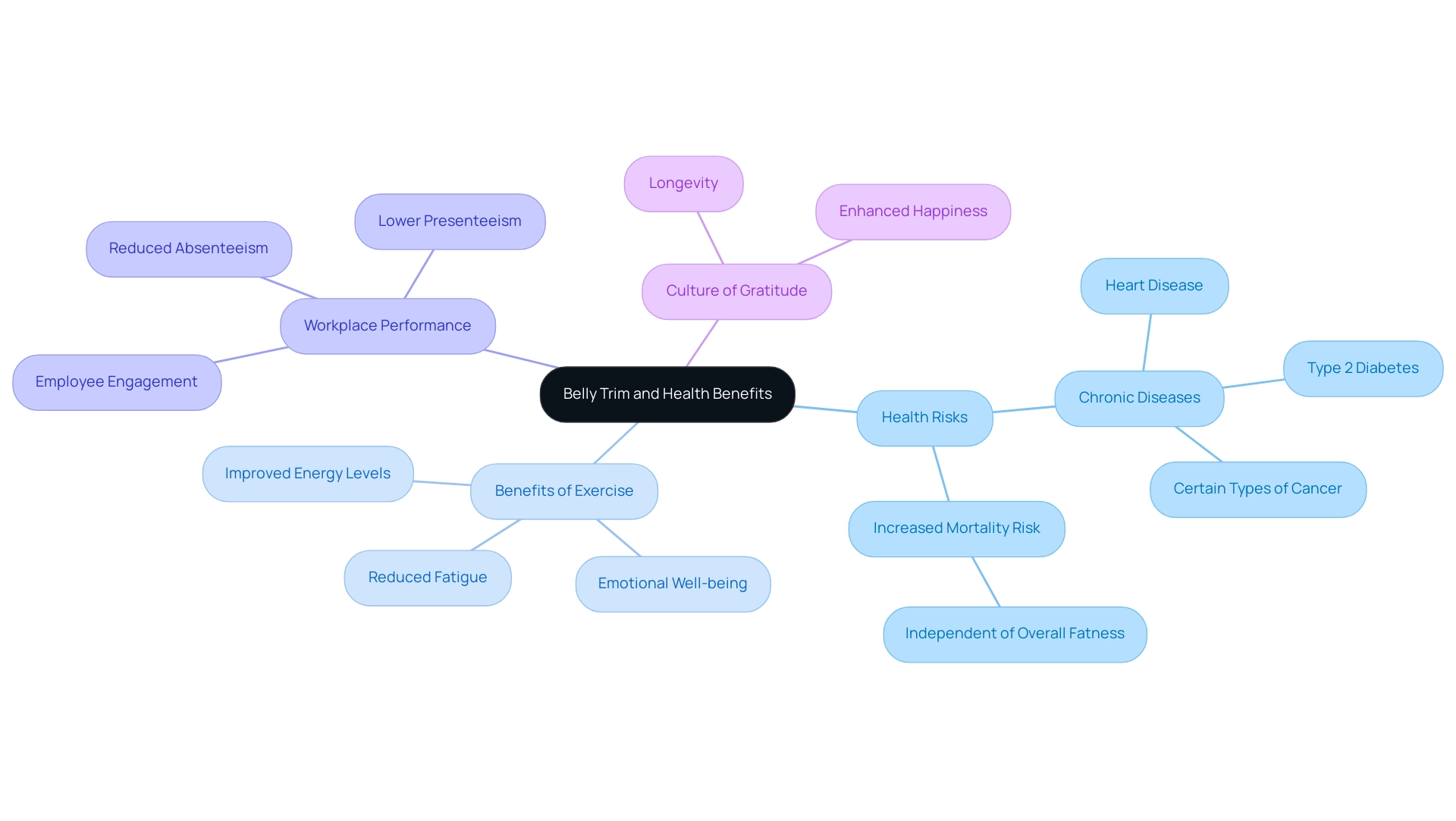
Effective Strategies for Achieving a Trim Belly: Diet and Exercise
Achieving a belly trim is not just about aesthetics; it’s a holistic process that involves thoughtful dietary changes and consistent physical activity. A balanced diet centered on whole foods—think vibrant fruits, nutrient-packed vegetables, lean proteins, and wholesome grains—is essential. By cutting back on processed foods, added sugars, and unhealthy fats, individuals can significantly reduce belly fat.
Furthermore, integrating fiber-rich foods into meals supports digestion and fosters a sense of fullness, which is key to avoiding overeating. Notably, studies have shown that individuals following moderately high protein diets achieved greater fat mass loss, averaging −6.2 kg compared to those on standard protein diets. On the exercise front, a blend of cardiovascular activities like running, swimming, or cycling, paired with strength training, is proven to effectively burn fat while building muscle.
High-Intensity Interval Training (HIIT) stands out as particularly powerful for targeting belly fat. Setting realistic goals, closely monitoring progress, and choosing enjoyable activities can significantly boost motivation and adherence to these lifestyle changes. Embracing these strategies not only works towards belly trim but also enhances overall health, elevates self-confidence, and positively impacts workplace performance.
As healthcare providers emphasize,
- "Healthcare providers should consult with patients before choosing the optimal diet strategy because successful weight loss and its maintenance depend on the patient’s choices, preferences, and long-term adherence to the diet plan."
Additionally, with Foresight Health Coaching's comprehensive health programs, which include personalized fitness coaching, daily workouts, guided nutrition, and nutrition services through an intuitive app, HR Benefits Managers can empower their teams with the tools to achieve these goals efficiently. The app also features habit formation techniques, community support, and accountability measures that foster a collaborative environment.
Current trends in weight loss supplements, such as the systematic review on green coffee extract and a clinical trial on fucoxanthin, highlight the importance of ongoing research in this area, providing further context for HR Benefits Managers considering wellness programs.
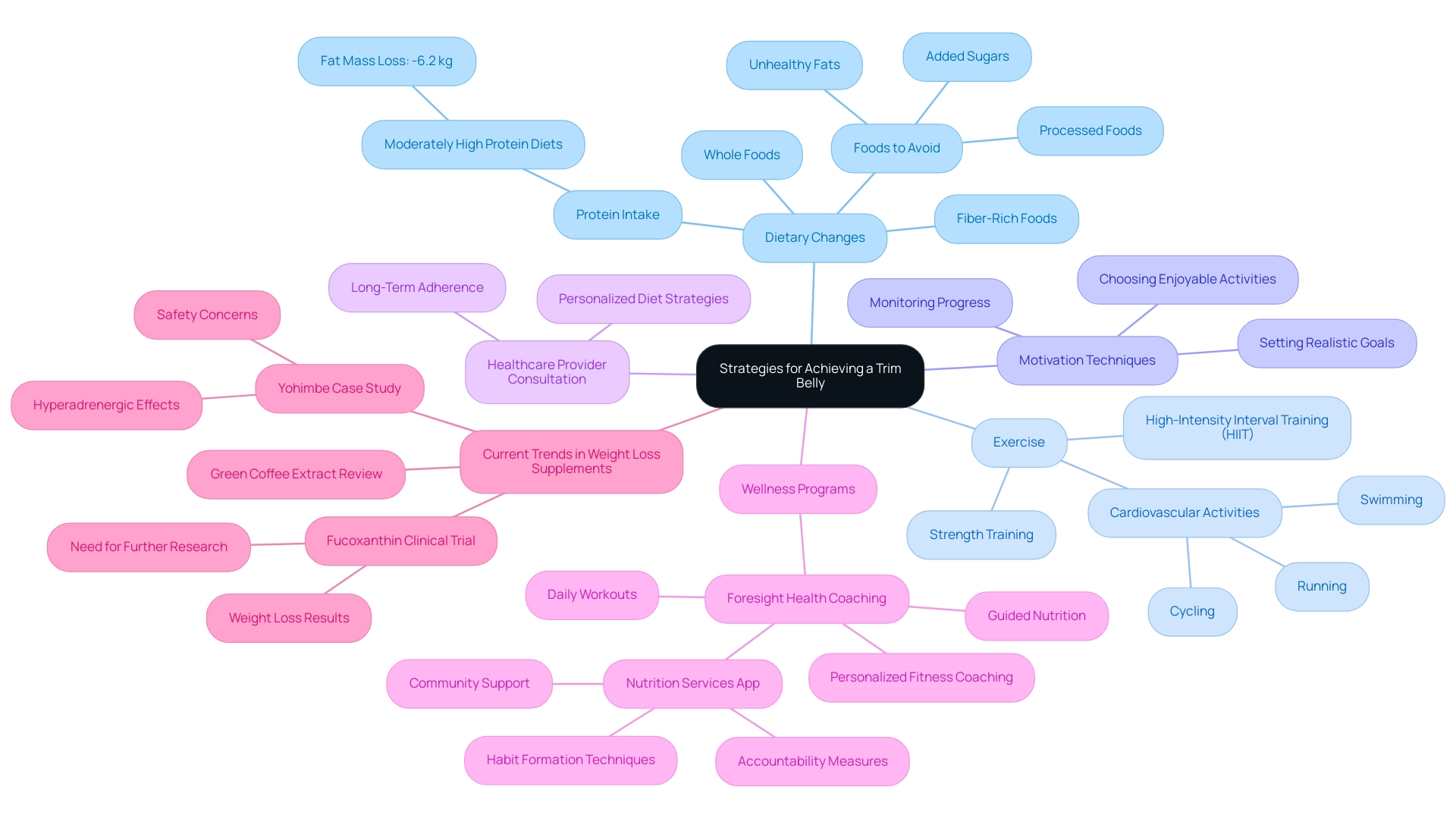
The Psychological Impact of Belly Fat: Understanding Mind-Body Connection
The buildup of belly trim can profoundly influence an individual's psychological state, often manifesting in low self-esteem, anxiety, and depression. Research indicates a strong mind-body connection, where perceptions of body image significantly influence overall well-being. Significantly, thorough evaluations indicate that between 20% and 60% of individuals struggling with obesity encounter psychiatric disorders, a statistic that highlights the mental well-being crisis linked to excess weight.
As Dr. Mir Ali, a respected bariatric surgeon, points out,
My patients tell me they are consistently discriminated against because of their weight,
highlighting the societal pressures that exacerbate these issues. Furthermore, studies illustrate that individuals with higher levels of abdominal fat frequently report negative body image, which can lead to maladaptive coping strategies such as emotional eating and reduced physical activity. The study by Farias et al. (2020) also demonstrates that weight loss can positively impact inflammation and endothelial markers, suggesting a link between physical well-being improvements and psychological outcomes. Moreover, the case study titled 'Body Esteem as a Mediator Between Physical Activity and Depression' highlights how body esteem affects mental well-being, particularly in promoting a positive self-image through physical activity. Conversely, achieving a belly trim can significantly boost self-confidence and foster a more positive self-image, which are essential components for mental well-being.
By cultivating a workplace culture that promotes healthy lifestyle choices, organizations can play a pivotal role in enhancing both the physical and mental health of their employees. This not only leads to a more engaged workforce but also reinforces the urgency for HR Benefits Managers to take action in creating a supportive environment where individuals can thrive.
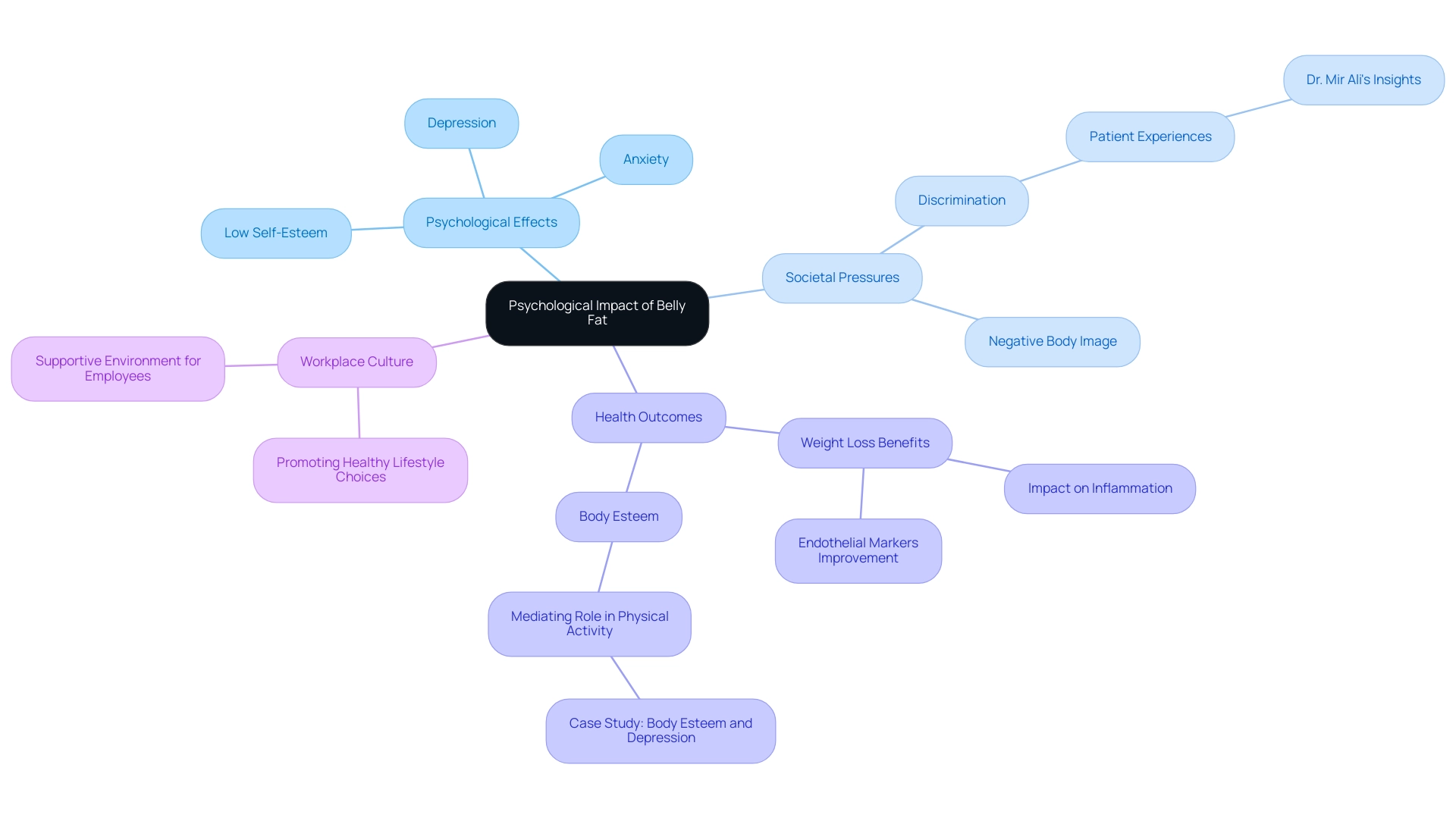
The Role of Sleep and Stress Management in Achieving a Trim Belly
Achieving a belly trim hinges significantly on effective sleep and stress management strategies, which are essential components of our tailored corporate health programs. Insufficient sleep disrupts hormonal balance, increasing appetite and cravings for unhealthy foods, leading to weight gain, especially in the abdominal area. Additionally, high-stress levels trigger the release of cortisol, a hormone linked to fat accumulation in the belly.
Research shows that habitual short and long sleepers face heightened obesity risks over a decade, underscoring the need for adequate rest. Therefore, prioritizing 7-9 hours of quality sleep each night is vital. By incorporating proven stress-reduction techniques—such as mindfulness, meditation, and regular physical activity—our wellness programs effectively combat these challenges.
As Dr. Rehman, a board-certified physician in Internal Medicine and Endocrinology, emphasizes, managing both sleep and stress is critical for overall well-being. The financial implications are significant; insomnia treatment costs upward of $1,500 per year, which can burden both individuals and organizations. The U.S. faces substantial economic losses due to insufficient sleep, estimated at $411 billion annually, highlighting the urgent need for workplace initiatives that promote effective sleep management strategies.
By fostering a balanced approach that integrates sufficient rest and effective stress management, individuals can significantly enhance their journey toward achieving belly trim, ultimately bolstering their overall health and productivity. Moreover, investing in these health programs not only helps in decreasing absenteeism and healthcare expenses but also leads to a healthier, more engaged workforce, emphasizing the importance of prioritizing staff well-being.
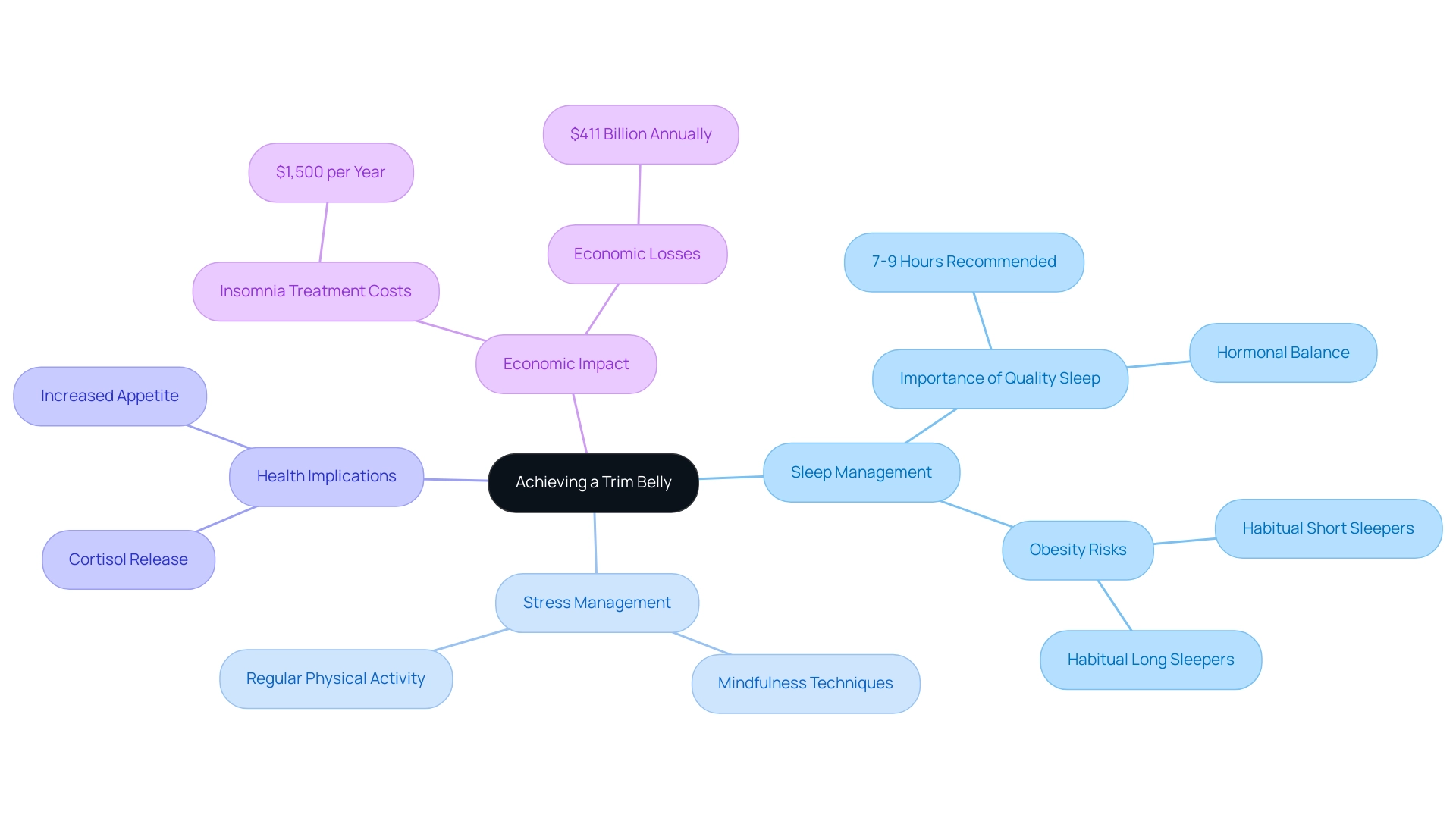
Creating a Supportive Environment for Belly Trim Goals in the Workplace
Creating a supportive atmosphere is vital for enabling individuals to achieve their goals for belly trim. Organizations can implement comprehensive health programs that encourage physical activity, promote healthy eating, and address stress management. Involving activities like group fitness sessions, healthy eating competitions, and health seminars not only inspire staff but also foster a sense of community within the workplace.
Additionally, collaborating with Foresight Health Coaching offers access to valuable resources such as nutritionists and lifestyle coaches, equipping staff with the tools they require to make informed choices regarding their well-being. To further support your team's well-being objectives, consider utilizing our free 7-day trial offer for our transformative coaching application.
The effect of these programs is significant; an astonishing 89% of staff involved in health initiatives report increased engagement and satisfaction in their roles. Studies show that inadequate habits and heightened risks contribute to increased presenteeism, indicating that programs focused on these aspects can enhance productivity. As Mike Lovett, Senior Content Marketing Specialist at Workhuman, emphasizes, "When individuals feel supported from the very top and receive recognition at least a few times a month from managers, leaders, and/or peers, they are up to 4x as likely to strongly agree that they belong at their organization."
By prioritizing health and well-being, organizations not only support their staff in reaching their health objectives but also improve overall productivity, morale, and job satisfaction. However, despite the benefits of wellness programs, participation can be low. A 2021 report from Gartner suggests that lowering barriers to entry and clearly communicating benefits are essential for enhancing staff engagement.
A culture that prioritizes well-being leads to reduced absenteeism and improved employee retention, creating a win-win situation for both individuals and the organization as a whole. With targeted initiatives and a commitment to fostering a supportive workplace culture, HR Benefits Managers can significantly influence the health outcomes of their teams.
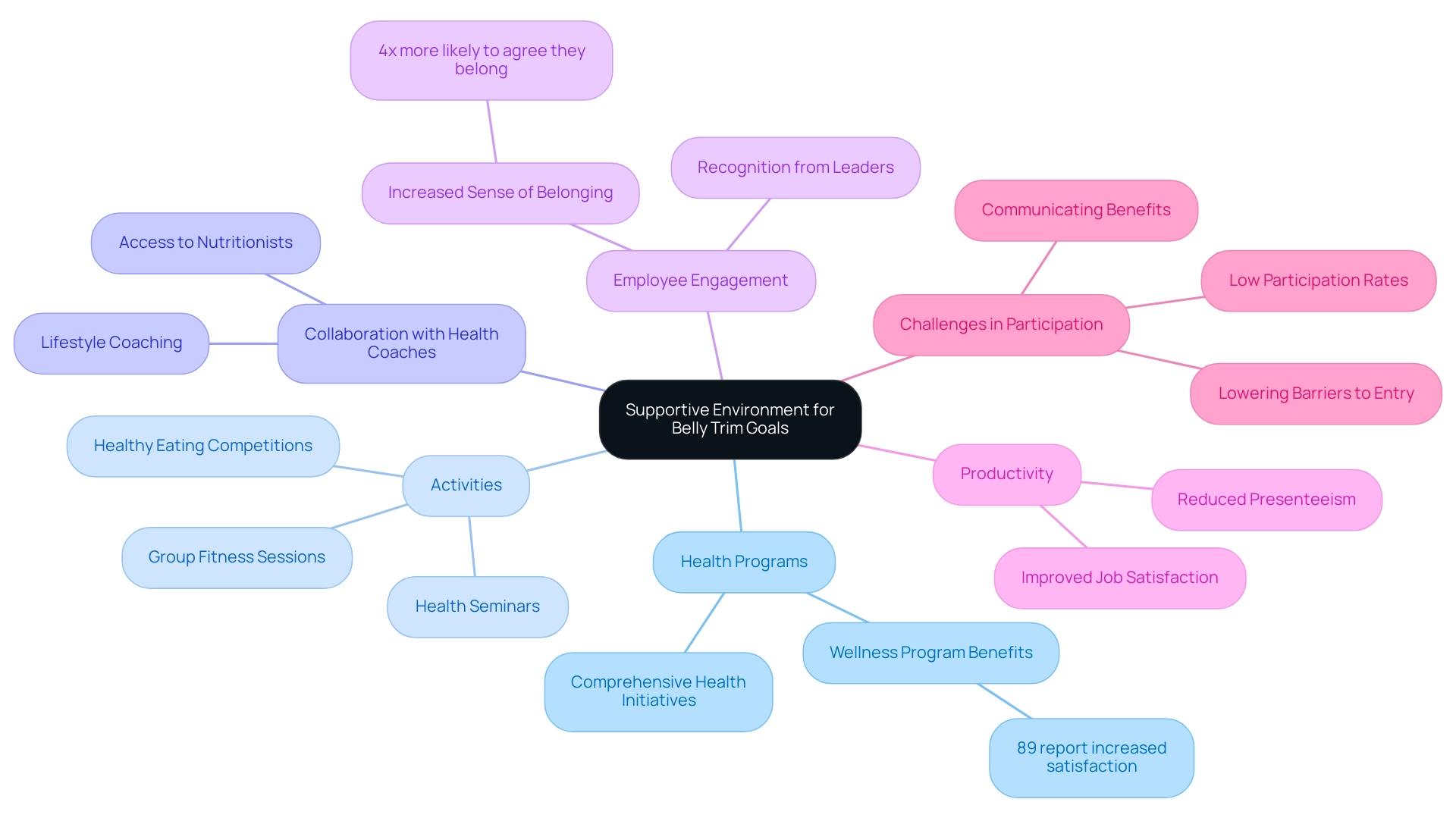
Conclusion
Recognizing the importance of a trim belly is crucial for enhancing workplace health and productivity. The evidence is clear: managing belly fat is not just about appearance; it directly impacts chronic disease risk, employee morale, and overall workplace performance. Through effective strategies in diet, exercise, sleep, and stress management, individuals can significantly improve their health outcomes and, in turn, contribute to a more engaged workforce.
Moreover, the psychological implications of body image cannot be overlooked. A supportive workplace culture that encourages healthy lifestyle choices fosters self-esteem and mental well-being, which are essential for sustaining motivation and productivity. By creating an environment that prioritizes health and wellness, organizations not only empower employees to achieve their personal health goals but also cultivate a thriving workplace atmosphere.
Investing in comprehensive wellness programs is a strategic move that pays dividends in employee engagement, reduced absenteeism, and enhanced job satisfaction. HR Benefits Managers have a pivotal role in championing these initiatives, leading to a healthier workforce and a more productive organization. The time to act is now; prioritizing employee well-being will create lasting positive impacts that resonate throughout the entire workplace.




